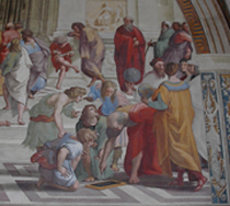Gregg Jaeger carries out research in quantum computing, quantum cryptography, foundations of quantum mechanics, quantum metrology, history and philosophy of science and population genetics.
RESEARCH INTERESTS:
"My work centers fundamentally on the inquiry into the ontology of quantum theory. In my early career, Ihave explored ways the interrelation between quantum two-level subsystems ("qubits"), and how they can be used in practice to probe physical systems to perform quantum metrology (click here to see a review article). My early work produced on two new, fundamental quantum complementarity relations and experimentally verified their validity and use in practice. These are the relation between single-particle interference visibility and path distinguishability and the relation between single-particle and two-particle interference visibilities. Together with Abner Shimony, I also found a fundamental bound on the distinguishability of non-orthogonal quantum states. (See the "Articles" section for articles in .pdf format.) The quantum metrology techniques currently being developed in the Quantum Imaging Lab primarily use such systems.
From this basis, my students, collaborators and I have gone on to study increasing larger quantum systems through a broader array of techniques and to find more adequate concepts for conceiving of them as being and consisting of physical objects.
During the period 2001-2006, the Quantum Imaging Laboratory and collaborators at Harvard University and BBN Technologies built a practical metro area quantum cryptographic network, known as the DARPA Quantum Network Testbed, to which I contributed as the principal quantum entanglement theorist. During this project, for the first time 1550 nm (the main telecomm. wavelength) entangled photon pairs were shown to violate Bell inequalities (using superconducting single-photon detectors) and to be of practical use for quantum cryptography in a real-world computer network environment. (See the "Patents and News" section for more information.) We later pursued a new, coherent-state based approach that will allow much greater rates and distances of secure QKD to be achieved through the use of entanglement witnesses and related quantities as an eavesdropping indicators.

I have since investigated coherence and entanglement in the larger quantum mechanical systems used for quantum information processing. This involves clarifying the character of entanglement in many-particle systems, such as by determining the relationship between entanglement and mixedness in arbitrarily large quantum systems. My students, collaborators and I have often pursued the question of the general relationship between quantum entanglement and decoherence in multiple-qubit and mulitiple qu-d-it systems and inducing entanglement death.
I have most recently also been explicitly investigating the fundamental nature of quantum objects, particularly in quantum field theory, focusing on the operation of exchange forces via virtual particles and exploring the relationship of particles to quantum fields. This has resulted in the demonstration that particles supervene on quantum fields rather than being simple field mode excitations as often thought." Back to main page